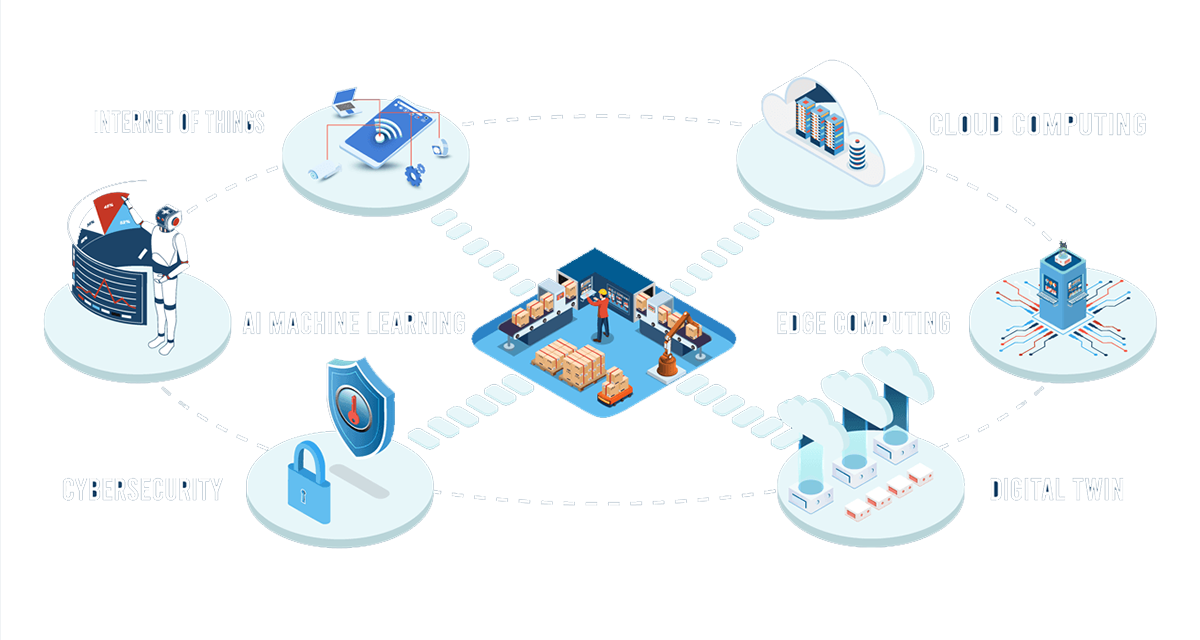|
How Digi-Arc Supports Manufacturing and Service Needs on the Factory Floor
|
1. Enabling Real-Time Data Collection & Analytics
Edge Devices & IIoT Integration:
- Digi-Arc designs architectures that connect factory assets (PLCs, sensors, machines) to IIoT platforms.
- Use edge computing to process data locally, reducing latency and enabling real-time insights.
Data Pipelines & Visualization:
- Implement data pipelines that extract, transform, and load (ETL) shop floor data into centralized data lakes or cloud platforms.
- Enable real-time dashboards and visualizations using Power BI, Tableau, or Grafana.
Predictive Maintenance & Anomaly Detection:
- Leverage machine learning algorithms to predict equipment failures and optimize maintenance schedules.
- Use anomaly detection techniques to identify deviations in production quality.
Example:
On a pharma factory floor, real-time monitoring of temperature, humidity, and batch deviations ensures compliance with GMP standards.
|
|
|
2. Driving Digital Manufacturing with MES & ERP Integration
MES (Manufacturing Execution System) Integration:
- Digi-Arc designs solutions that connect MES with ERP systems (SAP, Oracle) and warehouse systems (WES/eWM) for synchronized production planning.
- Enable real-time work-in-progress (WIP) tracking and automated production scheduling.
Low-Code/No-Code Platforms for Shop Floor Apps:
- Use platforms like Tulip, Plex, or Siemens Mendix to build custom apps for operators and supervisors.
- Apps streamline tasks such as quality checks, maintenance logging, and downtime reporting.
ERP-Driven Material Management:
- Real-time inventory and material flow visibility using ERP integration reduces downtime and optimizes production planning.
Example:
In a discrete manufacturing plant, MES-ERP integration ensures real-time production scheduling and automated lot tracking.
|
|
|
3. Smart Maintenance & Asset Management
Digital Twins for Asset Monitoring:
- Architects build digital twins of production lines or critical assets, simulating operations and predicting potential failures.
- Use IoT data streams to keep the twin synchronized with physical equipment.
Connected Maintenance Workflows:
- Integrate CMMS (Computerized Maintenance Management Systems) with MES and ERP.
- Automate maintenance work orders based on real-time asset conditions (e.g., vibration thresholds or thermal anomalies).
Example:
In an automotive plant, vibration sensors on stamping machines trigger automated service tickets when thresholds are exceeded.
|
|
|
4. Enhancing Service with AR/VR & Remote Assistance
Augmented Reality (AR) for Field Service:
- Digi-Arc designs AR solutions for remote diagnostics and guided maintenance.
- Field technicians use HoloLens or mobile AR apps to access real-time service manuals, schematics, and expert assistance.
Remote Monitoring & Service Portals:
- Deploy customer portals for service visibility, allowing clients to track asset conditions, request services, and monitor SLAs.
IoT-Powered Service Models:
- Architects enable IoT-powered predictive service models, reducing unplanned downtime through remote monitoring and preemptive part shipments.
Example:
In an industrial equipment plant, AR-guided maintenance reduces service times by 30%.
|
|
|
5. Cloud & Edge Integration for Scalable Solutions
Cloud-Native Architectures:
- Design scalable platforms on AWS, Azure, or Google Cloud to store and process large volumes of factory data.
- Use API gateways and microservices for seamless integration with existing systems.
Edge Computing for Low-Latency Needs:
- Deploy edge devices to process machine data locally, reducing the need for constant cloud connectivity.
- Use MQTT or OPC UA protocols to stream relevant data to cloud platforms for further analysis.
Example:
In a pharmaceutical factory, edge devices process GMP-compliant sensor data locally to prevent latency issues.
|
|
|
6. Cybersecurity & Compliance
Secure Factory Networks:
- Digi-Arc implements zero-trust architectures to protect OT and IT networks.
- Use role-based access control (RBAC) and network segmentation to prevent unauthorized access.
Compliance with Industry Standards:
- Ensure systems align with ISO 27001, NIST, and GxP requirements.
- Regular audit trails and logs for compliance verification.
Example:
In a medical device plant, adherence to 21 CFR Part 11 ensures secure data logging and traceability.
|
|
Key Technologies Involved
- Platforms: Tulip, Siemens MindSphere, AWS IoT, Azure IoT, Google Cloud IoT
- Protocols: MQTT, OPC UA, REST APIs
- Data & Analytics: Power BI, Snowflake, Grafana, Databricks
- Edge & Cloud: Azure Stack Edge, AWS Greengrass, Google Distributed Cloud
- AR/VR Tools: Microsoft HoloLens, PTC Vuforia, TeamViewer Frontline
Impact of Digi-Arc on the Factory Floor
- Improved Operational Efficiency: Real-time insights reduce downtime and optimize production.
- Enhanced Quality Control: Automated anomaly detection and traceability boost compliance.
- Streamlined Service Operations: Remote monitoring and AR-powered service improve response times.
- Scalable & Future-Proof: Cloud-native and edge architectures ensure scalability.
|






